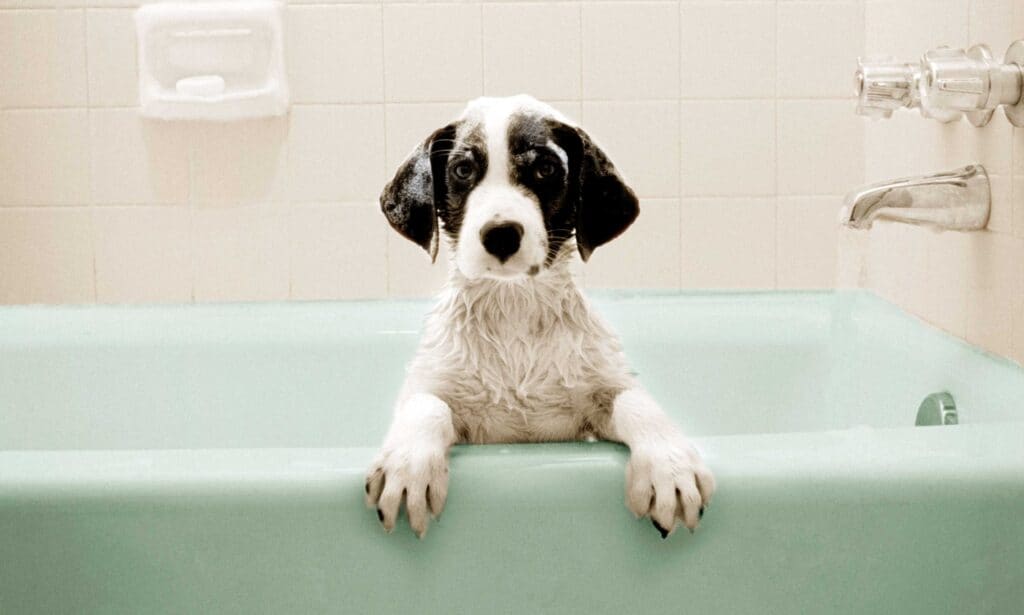It’s a scenario no dog parent wants to find themselves in: You let your dog outside before bedtime to do their business when they suddenly dart after something in the bushes. Before you know it, they’re returning with a pungent, unmistakable odor trailing behind them. They’ve been sprayed by a skunk!
Skunk spray is a smelly, oily substance that skunks use as a defense mechanism. This smell is not just unpleasant; it’s notorious for its staying power. Left untreated, skunk odor can linger on your dog for weeks. Fortunately, with swift action and the proper cleaning methods, you can more quickly rid your furry friend (and home) of that foul stench.
We spoke to a vet expert to understand exactly what to do if your dog gets sprayed by a skunk. But first, let’s cover some skunk basics.
What’s in Skunk Spray, Anyway?
Skunk spray is produced by the skunk’s anal glands and can be sprayed with remarkable accuracy at targets up to 15 feet away, says Dr. Doug Mader, MS, DVM, volunteer veterinarian at U.S. Fish and Wildlife Service and author of “The Vet at Noah’s Ark.”
But what makes this secretion so pungently unforgettable? Skunk spray is composed of seven different volatile compounds, with thiols being the primary compound responsible for that notorious “eau de skunk.”
Another compound in skunk spray, called thioacetate, is readily converted into thiols when mixed with water. This is why skunk odor becomes even more pungent when a skunked dog gets wet.
Thiols don’t just smell bad; they can also harm your dog.
“A pet on the periphery of the spray (10-15 feet away) may just need an in-home cleansing,” Dr. Mader says. But a direct spray can cause serious health complications, he adds.
What to Do When a Skunk Sprays Your Dog
When your dog gets sprayed, your immediate actions can make a big difference in how long and intensely they smell, and how greatly they’re affected.
How you handle the situation largely depends on how close your dog was to the skunk when the spraying occurred and where on their body they got sprayed.
Let’s review how to handle the most common scenarios:
Direct Spray to the Dog’s Eyes or Mouth
If your dog received a direct hit to the eyes or mouth, swift action is needed, as the thiols in skunk spray are absorbed readily across the eyes and through the mucus membranes of the mouth, says Dr. Mader.
If your dog was sprayed directly in the face, Dr. Mader recommends immediately flushing their eyes and mouth with tepid tap water.
“In this situation where the head is involved, it would be wise to make a visit to the vet emergency hospital to have the eyes flushed and treated with medications to cut down on irritation to the corneas,” he adds.
Body-Only Spray (Mild to Moderate)
If your dog seems to have been sprayed solely on their body (not their face) and was about 10-15 feet away when the skunk released its spray, an at-home bath should typically suffice.
Here’s how to handle this situation, according to Dr. Mader.
1Don’t Let Your Dog Inside Until Necessary
Some people may choose to wash their dog outside, while others may choose to wash them in the bathroom tub. Either way, don’t let your dog inside while you’re preparing their bath, as the strong odor can quickly permeate your home’s interiors, making it harder to remove later.
2Prepare a DIY De-Skunking Solution
The key to eliminating the skunk smell is neutralizing the thiols, which bind strongly and rapidly to skin proteins.
“Thiols are not water-soluble, even with soap,” says Dr. Mader. “A baking soda and peroxide mixture will oxidize thiols into water-soluble sulfonates, and these compounds can be rinsed off.”
Dr. Mader recommends the following homemade recipe, devised by chemist Paul Krebaum:
- 1 quart fresh 3% hydrogen peroxide
- ¼ cup baking soda (sodium bicarbonate)
- 1-2 teaspoons liquid dish soap
If your dog is very large, you can add 1 quart of lukewarm water to the mixture, so you’ll have enough solution to cover your whole dog. Mix these ingredients in a bucket or large bowl, and use immediately. Do not store.
What about bathing your dog in tomato juice? This is a popular myth, and it does not effectively neutralize skunk odor.
3Apply the Solution Carefully
Now it’s time to put the de-skunking solution to work.
- Wearing rubber gloves, gently massage the hydrogen peroxide solution into your dog’s fur, being cautious to avoid their eyes, ears and mouth.
- Let the solution sit on your dog’s coat for about five minutes before thoroughly rinsing. Be sure not to leave the solution on too long, as hydrogen peroxide can bleach dog fur.
Sometimes, a single treatment isn’t enough to eliminate the skunk odor. You may need to repeat the washing later in the day and in the following days.
4Consider Commercial Products
If the homemade solution doesn’t fully eliminate the odor, or if you’d prefer a ready-made solution, consider buying a specialized skunk odor remover shampoo. These types of products can be used in place of or in addition to the homemade solution.
A few options to consider include:
Can Skunk Spray Harm My Dog?
While skunk spray is primarily known for its foul odor, it can also have adverse effects on dogs. These may include:
- Eye irritation: If the skunk spray gets in your dog’s eyes, the chemicals in the spray can cause redness, itching and a temporary burning sensation. In some cases, the spray can cause damage to the cornea and temporary blindness.
- Oral and nasal discomfort: If the spray enters the dog’s mouth or nose, it can cause irritation. Your dog may drool excessively, sneeze or even vomit due to the strong taste and smell.
- Skin irritation: Prolonged contact with skunk spray can lead to skin irritation. If your dog’s skin is particularly sensitive or they have an underlying skin condition, the irritation might be more pronounced.
- Anemia: In rare cases, exposure to skunk spray can cause a potentially life-threatening condition called methemoglobinemia—a serious type of anemia in which the dog’s red blood cells are destroyed, explains Dr. Mader. This typically occurs a few hours to 24 hours after exposure. Signs of anemia may include weakness; vomiting; lethargy; discoloration of the skin and mucous membranes; and rapid breathing. Anemia is more likely to occur after a heavy spray, multiple exposures or ingestion of the spray.
After you perform immediate at-home care, you should promptly take your dog to a veterinarian if they:
- Were sprayed directly in the eyes and mouth, especially at a close distance
- Were sprayed extensively on their body at a close distance (less than 10 feet away)
- Are exhibiting signs of anemia
- Are exhibiting severe symptoms of skin, eye or mouth irritation despite following the above protocols
- Are exhibiting symptoms that don’t clear up within 1-3 days
Why Do Skunks Spray?
Skunks don’t spray just for the fun of it; this potent defense mechanism is reserved for genuine threats.
Skunks, being relatively small and slow-moving creatures, don’t have many defenses against potential predators. The ability to emit a foul-smelling spray is their primary method of protection.
When confronted by something they perceive as a threat—like foxes, coyotes, domesticated dogs and cats, or even humans—skunks release their spray as a last resort.
Before spraying, they usually give a series of warnings such as hissing, stomping and raising their tail. Unfortunately, these initial warning signals are often lost on curious dogs, who see skunks as intriguing playthings or potential prey.
The intense smell of skunk spray serves as a strong deterrent. Once an animal experiences the foul odor and the burning sensation of the spray (especially if it contacts the eyes), they’re likely to back off and leave the skunk alone.
When Are Skunks Most Active?
Skunks are nocturnal creatures, so they’re most active at dusk, twilight and nighttime.
As for time of year, skunks become dormant in the winter but become more active as the weather warms up.
This means you are more likely to see skunks—and potentially have an unfortunate encounter with one—in the spring and summer.
More dog grooming tips:
Share:













